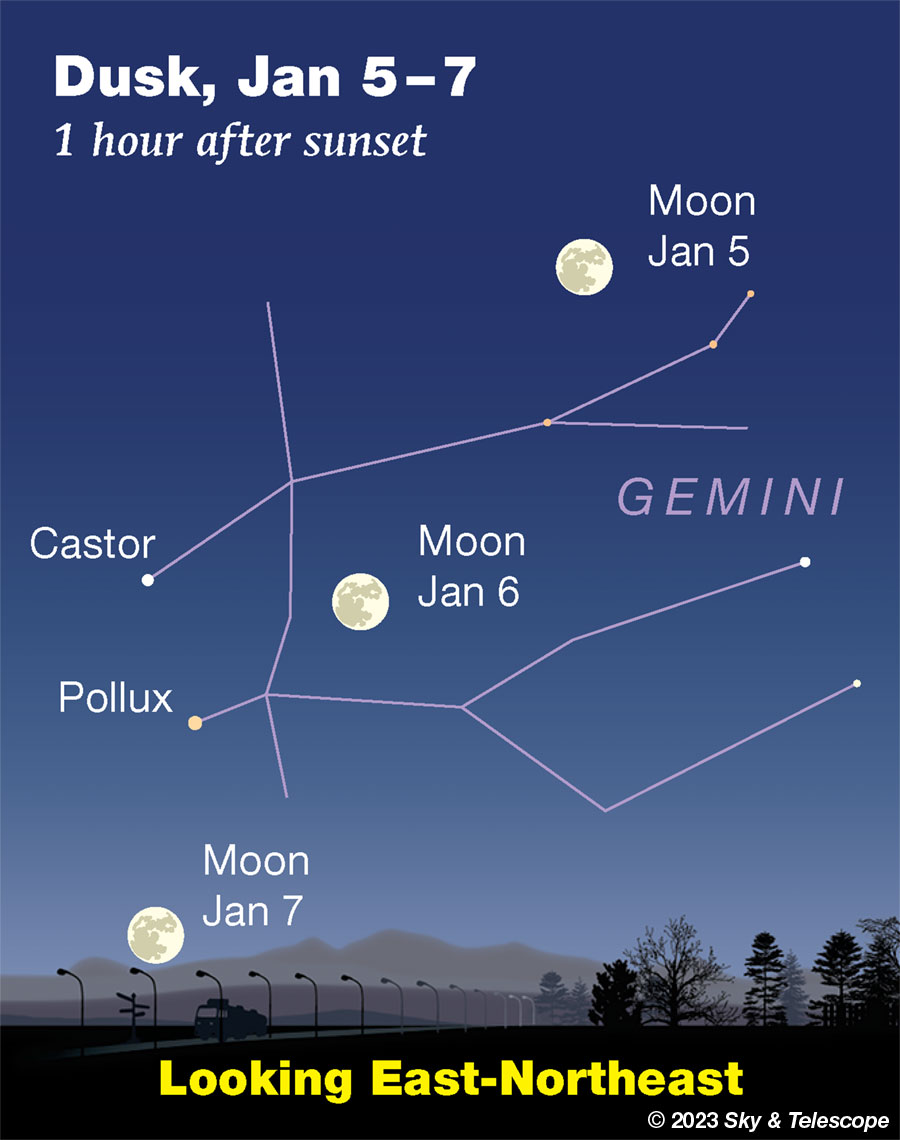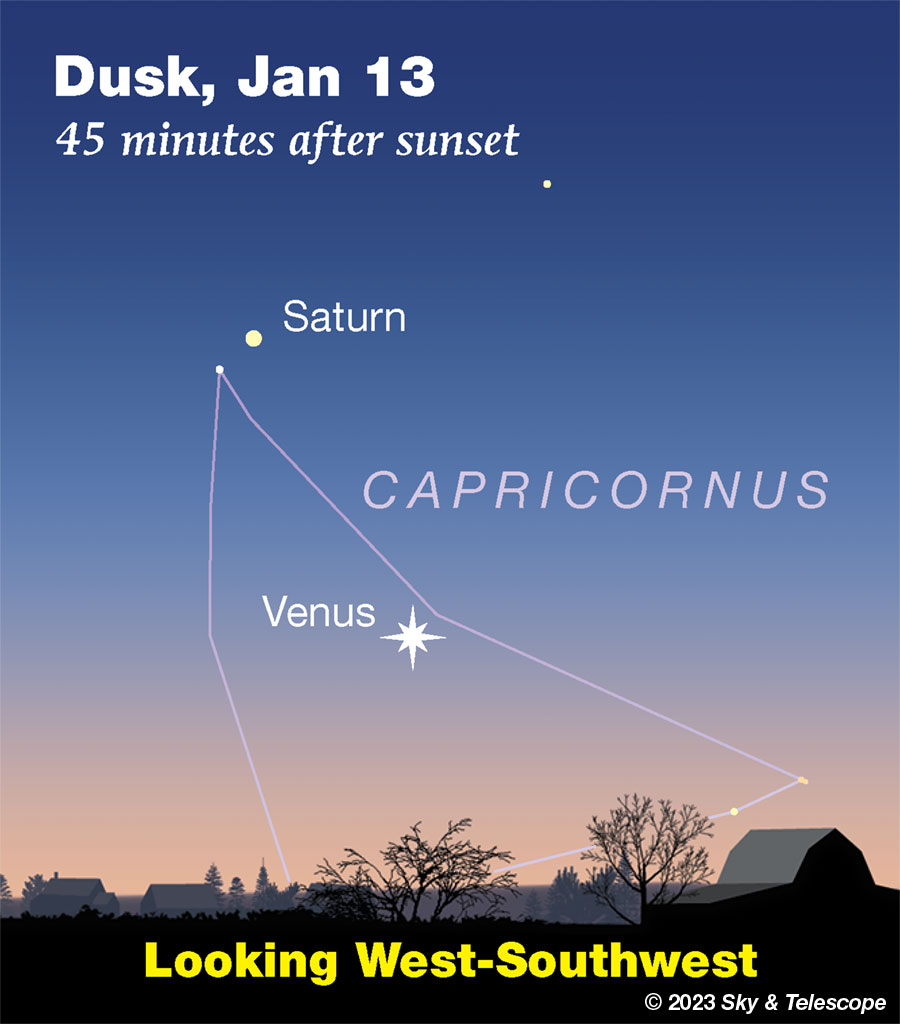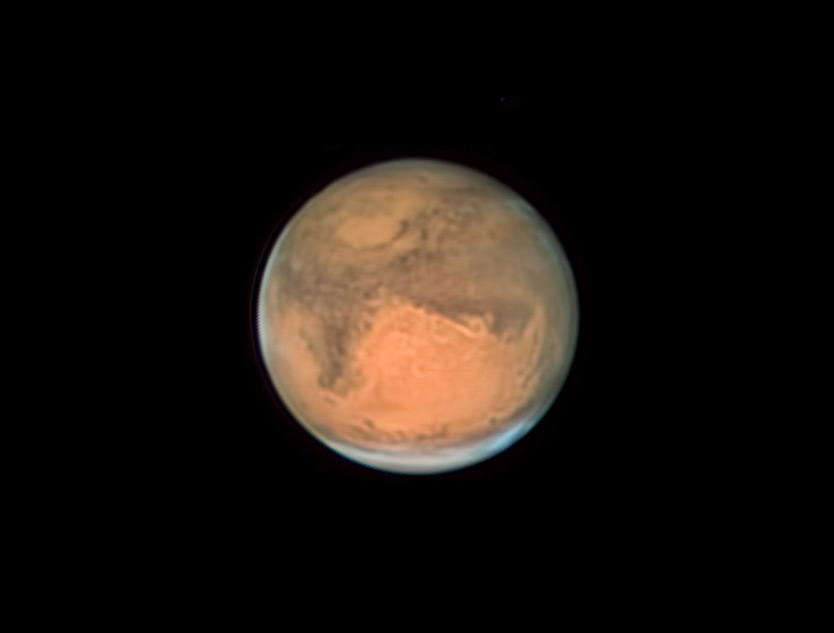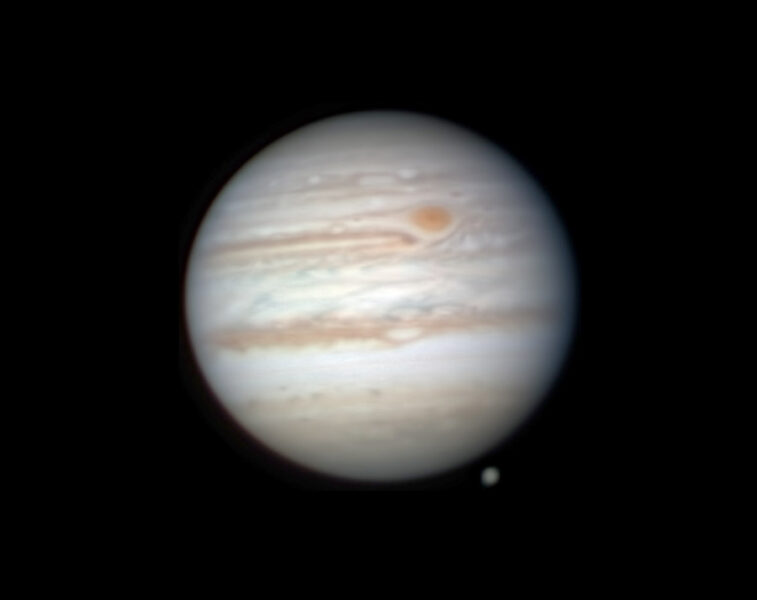FRIDAY, JANUARY 6
■ Full Moon (exact at 6:08 p.m. EST). The Moon rises in the east-northeast just before sunset. After nightfall you can see that it shines between the hearts of the Gemini stick figures, if you use binoculars to help piece out the constellation through the moonlight. See the illustration below.
The Moon also forms a nice, more or less isosceles triangle with Castor and Pollux, Gemini's head stars, to its left. Watch this triangle change shape a bit through the night as the Moon moves eastward along its orbit: toward the Moon for Jan. 7 in the scene below.

Note: The Moon in these diagrams is always drawn about three times its actual apparent size. The actual Moon moves against the background stars by its own diameter (about ½°) every hour or so. But in these illustrations, it takes about three hours to move by its own diameter. Still, that's fast enough to change the shape of the triangle it makes with Castor and Pollux during the course of this evening.
SATURDAY, JANUARY 7
■ Now the bright Moon shines below Castor and Pollux in the evening, as shown above.
■ After dinnertime, the enormous Andromeda-Pegasus complex runs from near the zenith down toward the west horizon. Near the zenith, spot Andromeda's high foot: 2nd-magnitude Gamma Andromedae, slightly orange. Andromeda is standing on her head. Almost halfway down from the zenith to the west horizon is the Great Square of Pegasus, balancing on one corner. Andromeda's head is its top corner.
From the bottom corner run the stars outlining Pegasus's neck and head, ending at his nose: 2nd-magnitude Enif, due west. It too is slightly orange.
SUNDAY, JANUARY 8
■ By 9 or 10 p.m. the waning gibbous Moon is well up in the east, at the Sickle of Leo. It forms another isosceles triangle with two stars: this time Regulus (lower right of it) and Algieba (lower left of it). These are the two brightest stars of the Sickle.
MONDAY, JANUARY 9
■ Endless action at Jupiter: At 7:02 p.m. EST, Jupiter's inner moon Io crosses onto Jupiter's face from the east, seeming to merge with it. Eleven minutes later Ganymede appears out from behind that same side of the planet. No, that's not Io bouncing off Jupiter!
Then at 8:20 p.m. EST Io's tiny black shadow starts crossing Jupiter's face, following behind in Io's footsteps. At 9:16 EST Io itself finally buds off into open view from Jupiter's western side.
Then at 9:41 p.m. EST Ganymede, still close to Jupiter's eastern limb where it reappeared, slowly slips into eclipse by Jupiter's shadow and remains in it for the next 2½ hours.
These dances around Jupiter have been carrying on steadily, day by day and hour by hour, since the solar system formed 4.6 billion years ago. Only in the last ten-millionth of that time has any living creature had a telescope to witness this happening at all. Consider yourself fortunate.
Meanwhile, on Jupiter itself, the Great Red Spot rotates into view and then crosses the planet's central meridian around 9:48 p.m. EST. For Easterners Jupiter will be very low by that time, but farther west it will still be fairly high.
TUESDAY, JANUARY 10
■ The big Northern Cross in Cygnus, topped by Deneb, is roughly upright in the west-northwest after dinnertime. By 7 or 8 p.m. it's standing on the horizon. How straight it stands there depends on your latitude.
WEDNESDAY, JANUARY 11
■ Now that the Moon is gone from the early evening sky, and if your sky is even moderately dark, try tracing out the winter Milky Way arching very high. In early evening it extends up from the west-northwest horizon along the Northern Cross of Cygnus, up and over to the right past dim Cepheus and then through Cassiopeia high in the north, then to the right and lower right through Perseus and Auriga, down between the feet of Gemini and Orion's dim club, and on down toward the east-southeast horizon between Procyon and Sirius.
THURSDAY, JANUARY 12
■ As we enter the depths of winter, the bowl of the Little Dipper hangs straight down from Polaris around 7 or 8 p.m. — as if (per Leslie Peltier) from a nail on the cold north wall of the sky.
The brightest star of the Little Dipper's dim bowl is Kochab, at the bowl's lip. It's the equal of Polaris. Kochab itself passes precisely below Polaris about 30 minutes before the center of the bowl.
The Big Dipper, meanwhile, is creeping up low in the north-northeast. Its handle is very low and its bowl is to the upper right.
FRIDAY, JANUARY 13
■ Orion leans bravely upward in the east-southeast after dark this week, and by 7 p.m. he's nice and high in the southeast with Sirius shining below him. Orion stands upright and highest by 10 p.m.
■ How well do you know Orion's Sword telescopically, beyond the familiar M42 and M43 nebulae and M42's Trapezium? Many double stars and groupings await along the sword. Use Ken Hewett-White's "Sword Scene" article, chart, photo, and list in the January Sky & Telescope, page 54.

That little star into 1.4° to Saturn's lower left is Delta Capricorni, magnitude 2.8. For this you'll need to wait until twilight is getting close to finished.
SATURDAY, JANUARY 14
■ Last-quarter Moon tonight (exactly so at 9:10 p.m. EST). The Moon rises around midnight or 1 a.m., with Spica about half a fist to its upper right. Brighter Arcturus is two fists to the Moon's upper left. Even in cold January, spring stars come out of hiding if you go out late enough.
■ Have you ever seen edge-on Mare Orientale peeking around the Moon's celestial eastern limb? And the Rook and Cordillera Mountains, Lacus Veris, and Lacus Autumni in its near-limb foreground? It takes a favorable lunar libration to tilt this region into telescopic view, and we get one of these for a few days around tonight. Or rather, tomorrow morning. The waning Moon, with its celestial-east limb sunlit, will be up in the hours before dawn. Best view will be not long before the start of your local dawn. Plan to take your scope out two hours before sunrise. The Moon will be shining nicely high in the southeast.
Use your Moon map and Tom Dobbins' "Observing on the Edge" article, with guide photo, in the January Sky & Telescope, page 52. Add a sea and a couple of lakes to your lunar life list.
This Week's Planet Roundup
Mercury is hidden in the glow of sunrise.
Venus, very bright at magnitude –3.9, shines low in the west in twilight. It sets by twilight's end. As twilight fades and Venus gets lower, look for dimmer Saturn coming into view to Venus's upper left. They're drawing toward each other; 18° separates Venus and Saturn on January 6th, only 10° by the 13th. They're on their way to a close conjunction, 1/3° apart, on January 22nd.
Mars, in Taurus, shines high in the east at dusk and near the zenith as you face south by 9 p.m. Mars continues to fade slowly, from magnitude –1.0 to – 0.8 this week, as it shrinks from 14 to 13 arcseconds wide. Mars-colored Aldebaran, mag +0.8, is about 8° below it.

Jupiter, magnitude –2.4 in Pisces, shines high in the south-southwest in twilight, then sinks toward the southwest. Jupiter sets around 11 or midnight. Telescopically, it has shrunk to 38 arcseconds wide.
Look for the Great Square of Pegasus to Jupiter's upper right through the evening. Extend the line of the Square's upper left side down past the planet. This week Jupiter is still a trace west of that line. It will cross the line on January 23rd. To help judge this, hold a straightedge up to the sky or stretch a string tightly between your two hands.

Saturn, magnitude +0.8 in Capricornus, is getting low in the southwest at nightfall, far lower right of Jupiter and closing in on Venus. Saturn sets around 7 or 8 p.m.
In late twilight look about two fists at arm's length to Saturn's left for Fomalhaut, and about three fists to Saturn's right for Altair.
Uranus, magnitude 5.7 in Aries, moves high across the south during evening. It displays a tiny, very slightly blue-greenish gray disk 3.6 arcseconds wide. It a telescope at high power it's obviously non-stellar. See the Uranus finder charts in the November Sky & Telescope, page 49.
Neptune, magnitude 7.9 at the Aquarius-Pisces border about 9° west of Jupiter, gets lower through the evening ahead of Jupiter. Go for it right after dark. Neptune is just 2.3 arcseconds wide, again non-stellar in a telescope but requiring more effort than Uranus. It's slightly bluish gray, if you have enough aperture to show color at all in something this faint. See the Neptune finder charts in the September Sky & Telescope, page 49.
All descriptions that relate to your horizon — including the words up, down, right, and left — are written for the world's mid-northern latitudes. Descriptions and graphics that also depend on longitude (mainly Moon positions) are for North America.
Eastern Standard Time (EST) is Universal Time minus 5 hours. Universal Time is also called UT, UTC, GMT or Z time.
Want to become a better astronomer? Learn your way around the constellations. They're the key to locating everything fainter and deeper to hunt with binoculars or a telescope.
This is an outdoor nature hobby. For an easy-to-use constellation guide covering the whole evening sky, use the big monthly map in the center of each issue of Sky & Telescope, the essential magazine of astronomy.
Once you get a telescope, to put it to good use you'll need a detailed, large-scale sky atlas (set of charts). The basic standard is the Pocket Sky Atlas (in either the original or Jumbo Edition), which shows stars to magnitude 7.6.

Next up is the larger and deeper Sky Atlas 2000.0, plotting stars to magnitude 8.5; nearly three times as many. The next up, once you know your way around, are the even larger Interstellarum atlas (stars to magnitude 9.5) or Uranometria 2000.0 (stars to magnitude 9.75). And be sure to read How to Use a Star Chart with a Telescope. It applies just as much to charts on your phone or tablet as to charts on paper.
You'll also want a good deep-sky guidebook. A beloved old classic is the three-volume Burnham's Celestial Handbook. An impressive more modern one is the big Night Sky Observer's Guide set (2+ volumes) by Kepple and Sanner.
Can a computerized telescope replace charts? Not for beginners, I don't think, and not on mounts and tripods that are less than top-quality mechanically, meaning heavy and expensive. And as Terence Dickinson and Alan Dyer say in their Backyard Astronomer's Guide, "A full appreciation of the universe cannot come without developing the skills to find things in the sky and understanding how the sky works. This knowledge comes only by spending time under the stars with star maps in hand."
![]() Audio sky tour. Out under the evening sky with your
Audio sky tour. Out under the evening sky with your
earbuds in place, listen to Kelly Beatty's monthly
podcast tour of the heavens above. It's free.
"The dangers of not thinking clearly are much greater now than ever before. It's not that there's something new in our way of thinking, it's that credulous and confused thinking can be much more lethal in ways it was never before."
— Carl Sagan, 1996
"Facts are stubborn things."
— John Adams, 1770
 2
2








Comments
Rod
January 7, 2023 at 9:30 am
I am seeing some more reports on this comet from different sources. I viewed again this morning. Observed 0530-0600 EST/1030-1100 UT. 07-Jan-2023 1052 UT/0552 EST. Full Moon 06-Jan-2023 at 2308 UT. I could see ZTF (C/2022 E3) using 10x50 binoculars. Kappa Crb and Zeta2 Coronae Borealis stars made finding the location easy this morning. Faint, small fuzzy and coma. The Moon was very bright lower elevation in Gemini. Starry Night Pro Plus 8 shows the comet at mv +7.64. Stellarium 1.2 indicates mv + 7.64, theskylive.com shows mv +7.5 for the comet this morning. It is slowly increasing in apparent magnitude since my first observation early morning of 24-Dec-2022 using my 90-mm refractor telescope. Then the comet about 8.59 magnitude. Stellarium 1.2 shows the comet ~ 67 arcminute from Kappa Crb in Corona Borealis. Skies mostly clear, temperature 3C, winds 270/3 knots. Clouds have been a problem for viewing at my location but this morning, mostly clear.
You must be logged in to post a comment.
Rod
January 10, 2023 at 7:09 am
Some more comet observations this morning. Observed 0145-0345 EST/0645-0840 UT. Waning gibbous Moon in Leo this morning, very bright. Last Quarter Moon 15-Jan-2023 0210 UT. Near 0150 EST I observed a bright meteor streak across the sky from Arcturus location moving WNW. Estimate apparent magnitude -1.0 and it left a train behind, illuminated by bright moonlight. This may have been a late Quadrantid meteor. They streak at about 41 km/s. I picked out the comet C/2022 E3 (ZTF) using 10x50 binoculars near 0200 EST. Faint fuzzy. The 90-mm refractor telescope provided better views. I observed from 25x to 71x. At 25x, the comet and star Kappa CrB visible in the eyepiece FOV. Kappa CrB near 7:00 position, the comet fuzzy near 2:00 position, north up and mirror reverse view. They were separated by about 64 arcminutes according to Stellarium 1.2. There was a distinct double star visible too, HIP77252 double star. The double star ~ 41 arcminute angular separation from C/2022 E3 (ZTF). At 71x, the comet had more coma and some tail visible. The lower power view at 25x was nice because I could see Kappa CrB and the comet together in the FOV along with some other fainter stars. Starry Night Pro Plus 8 shows mv +7.41, Stellarium 1.2 shows mv + 7.41, and theskylive.com reports an apparent magnitude 7.5. The skies clear this morning with west winds 5 knots and temperature -2C. Some foxes and deer were out moving about while I observed. I used TeleVue 40-mm plossl for 25x, TeleVue 32-mm plossl for 31x, and TeleVue 14-mm Delos for 71x observations. This is my third observation of C/2022 E3 (ZTF) since I started viewing 24-Dec-2022.
You must be logged in to post a comment.
You must be logged in to post a comment.